Moving right along… It’s Day #26 in the Bread Baker’s Apprentice Challenge and we’re making Poolish Baguettes. As the name implies, these baguettes are made with an overnight poolish.
According to Peter Reinhart, “in the Coupe du Monde bread competition, the poolish baguette is now the standard that all countries must replicate.” These baguettes, created by Bernard Ganachaud, are made with a medium-extraction flour that isn’t available in America. This type of flour is slightly higher in ash content and bran than regular bread flour. It is similar to clear flour which is whole-wheat flour that has been sifted once (instead of the usual twice) to remove the bran and germ.
Obviously, we don’t have this special flour, so we’ll replicate it by sifting whole wheat flour once to remove the bran. According to the commentary in the book, this should provide the right amount of fiber and ash. I’m using home-milled whole wheat flour so this experiment will be fun!
Poolish Baguettes
Makes: 3 Baguettes
Ingredients:
- 1 cup (7 ounces) poolish
- 1 3/4 cups (8 ounces) whole-wheat flour, sifted
- 2 cups (9 ounces) unbleached bread or all-purpose flour
- 1 1/2 teaspoons (.37 ounce) salt
- 3/4 teaspoon (.08 ounce) instant yeast
- 1 1/8 to 1 1/4 cups (9 to 10 ounces) water, lukewarm
- Semolina flour or cornmeal for dusting
Directions:
Making the Poolish (get the list of ingredients here)
For the step-by-step instructions for making the poolish, please refer to the Ciabatta post. Remove the poolish from the refrigerator 1 hour before making the dough to take off the chill.
Making the Dough
Pass the whole wheat flour through a sifter or strainer, sifting out the bran. Sift as much of the flour through the strainer as will go and set aside the bran that remains in the strainer for another use – for example, making the Multigrain Bread Extraordinaire.
Stir together the flours, salt, and yeast in a mixing bowl or in the bowl of your electric mixer. I didn’t use a stand mixer for this bread. I just used a mixing bowl. Add the poolish and 1 1/8 cups of the water and stir with a large spoon until the ingredients form a ball.
I started out with a wooden spoon, then switched to the danish dough whisk.
Transfer the dough to a counter sprinkled with flour. Knead for 10 minutes, sprinkling more flour as necessary. The dough should be soft and pliable, tacky but not sticky.
Fermenting the Dough
Lightly oil a bowl and transfer the dough to the bowl, rolling it around to coat it with oil. Cover the bowl with plastic wrap and allow the dough to ferment at room temperature for 2 hours or until it doubles in size.
Remove the dough and knead it lightly for 1 minute.
Return the dough to the bowl and cover it again.
Ferment for additional 2 hours at room temperature or until the dough doubles in size again.
Shaping the Baguettes
Sprinkle flour on the counter and gently transfer the dough to the counter. Divide it into 3 equal pieces using a metal dough scraper. Try not to degas it anymore than necessary.
Shape the pieces into baguettes, as shown on page 74, or for detailed instructions on making baguettes, refer to the post on French Baguettes.
Proofing the Loaves
Prepare the loaves for proofing. I’m using the couche method. Refer to the Ciabatta post for detailed instructions on using a couche.
Proof the baguettes at room temperature for 50 to 60 minutes, or until they are about 1 1/2 times their original size.
Baking the Loaves
Prepare the oven for hearth baking. Make sure to have an empty steam pan in place. Preheat the oven to 500 degrees. For more detailed instructions on hearth baking, refer to the post on Pain À l’Ancienne Baguettes.
Score the baguettes. I used a serrated knife, but it was a bit too big and the slashes didn’t work very well. I recommend using a lame for scoring these baguettes.
The method described in the book is to dust a peel or the back of a sheet pan with cornmeal and transfer the dough pieces to the peel or pan. Then, slide the loaves onto the baking stone to bake. Instead of using this method, I decided to bake the loaves in a special baguette pan so they would keep their shape. Mags at The Other Side of Fifty had mentioned this pan on her blog and I decided to give it a try.
For detailed instructions on hearth baking, including using the steam pan and spraying the oven walls with water at 30-second intervals, refer to the post on Pain À l’Ancienne Baguettes.
Bake the loaves for 10 minutes, rotate for even baking if necessary, then continue to bake for 8 to 12 more minutes. The loaves should be a rich golden brown.
Remove the bread and cool on a rack for at least 40 minutes before slicing or serving.
Here is a shot of the crumb. Looks pretty good. Tastes great also. I like these baguettes!
The next bread in Bread Baker’s Apprentice Challenge is Portuguese Sweet Bread.
Cathy
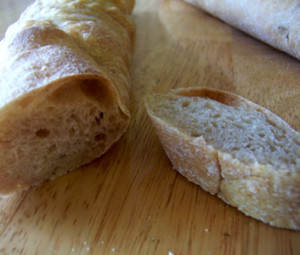

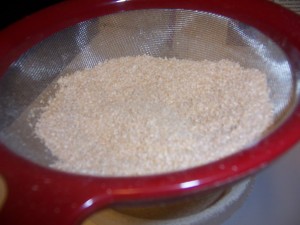
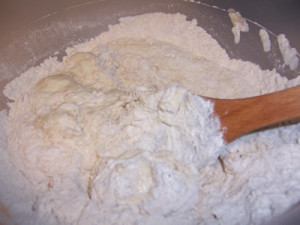
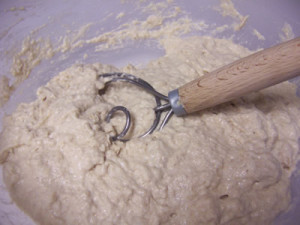
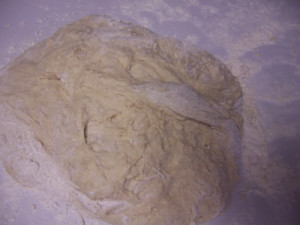
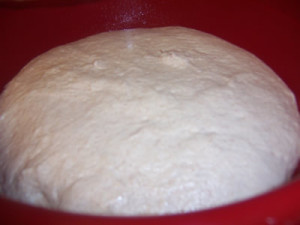
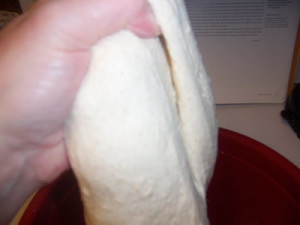
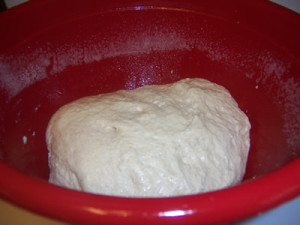
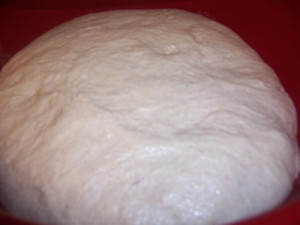
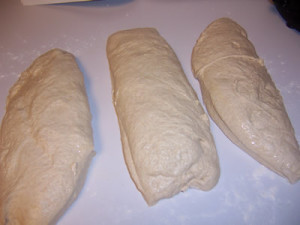
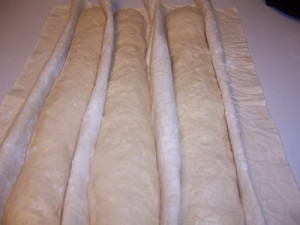
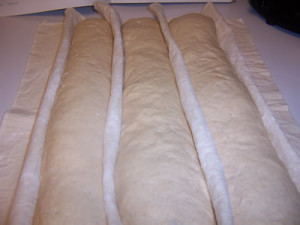
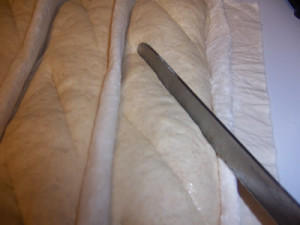
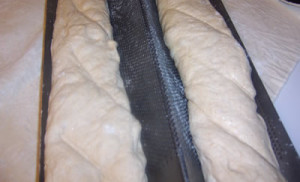
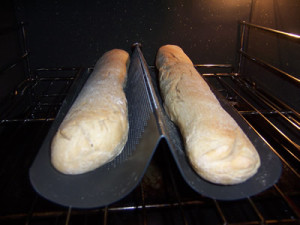
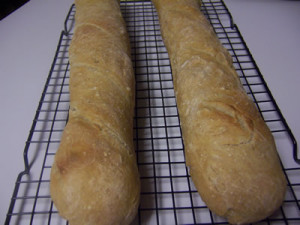
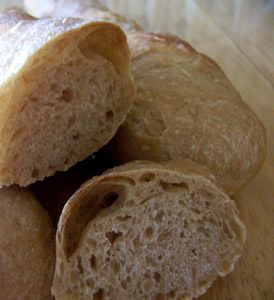
Frieda says
This is truly artisan bread, made totally by hand. Great job, Cathy!
Ezzie says
Looks delicious! I’ve done several methods like this. But had not heard about the special flour being used or sifting the white whole wheat. Great explanation! Thanks! I can just taste these with fresh butter slathered on them! Yum!
Cathy (breadexperience) says
Thanks Frieda and Ezzie! I like to do it by hand whenever possible. These loaves do taste great with fresh butter. I also think they’ll be good as garlic bread.
Joanne says
that baguette looks like it turned out perfectly! The inside looks like just the right amount of chewiness. Yum.
Cathy (breadexperience) says
Thanks Joanne! It tastes great too!
misterrios says
Nice color on the crust as well as a nice crumb. They look awesome!
Cathy (breadexperience) says
Thanks Misterrios! My oven doesn’t seem to brown Artisan loaves as well as I would like (without burning them) but I was pleased with the results on this one.
Anonymous says
Hi. I guess you meant to write in the ingredients list the use of 9 oz of white flour except those 8 of whole wheat flour?
Thanks. Will try your receipt.
Cathy (breadexperience) says
Yes, that is what I meant. Thanks for catching that! I updated the list of ingredients. I hope you enjoy the baguettes.
Diana says
And hi again. The measurements in ounces are definitely wrong: 1 cup = 7 ounces, and 2 cups = 9 ounces? I have some poolish waiting on the counter and would be greatful Cathy if you shared the correct amounts…that is in ounces. I could guide myself after the ‘cups’ measuring system though, but getting the best of one’s web-host domain is also a target, ain’t it?
Cheers.
The ciabatta following you recipe came out lovely, very tasty dough. I’ve tried a biga version before, but the poolish IS way better! Thank you.
Diana says
Well, I did realize that plain flour is obviously lighter than the poolish given the 1/1 .5 water/ flour ratio (hence the small difference between 7 oz poolish and 8-9 oz flour triggered the confusion above – seemed to be inappropriate for the 1 to 2 ‘cups’ ratio). I don’t know why I assumed there should be either more flour or less poolish to correspond to the cups measurements, and I have to admit I’m a novice both to using oz and to baking bread, however I guess I ended adding up more poolish, like 9.6 oz, also increased the white flour amount to 10 most likely and had like 8.5 oz whole wheat. The dough came soft, pliable and nice.
Sorry for intruding with bulk of chaotic math and useless ponderings on other’s experience and thanks again for sharing!
Good luck in baking better bread!
P.S. It definitely is also the flour that is heavier/lighter in different areas and the humidity that influence the measurements ultimately.
Cathy (breadexperience) says
Hi Diana,
The measurements in ounces is correct. It is taken directly from the book and I just verified that I didn’t type it in wrong. Not sure what getting the best of one’s web-host domain has anything to do with baking bread or this blog, but I’m delighted the ciabatta turned out for you.
You’re right! The flour weight does make a difference and the humidity as well. Not to mention that all measuring cups are different. It can be confusing to say the least. That’s why I’ve started using a scale (whenever possible) to measure the flour rather relying solely on measuring cups.
Happy Baking to you as well!
Cathy
VTak says
Hi, I’m making this same loaf from the same book but came to the Internet hoping for some clarification. Did you use the whole amount of poolish or just 1 cup (198 grams) of it? I know you use the whole amount for the ciabatta & I think you just use 1 cup (198 grams) for the baguettes but keep second guessing myself. Any help is greatly appreciated
Cathy says
Hi, to make the BBA poolish baguettes, just use 1 cup of the poolish in the final dough.